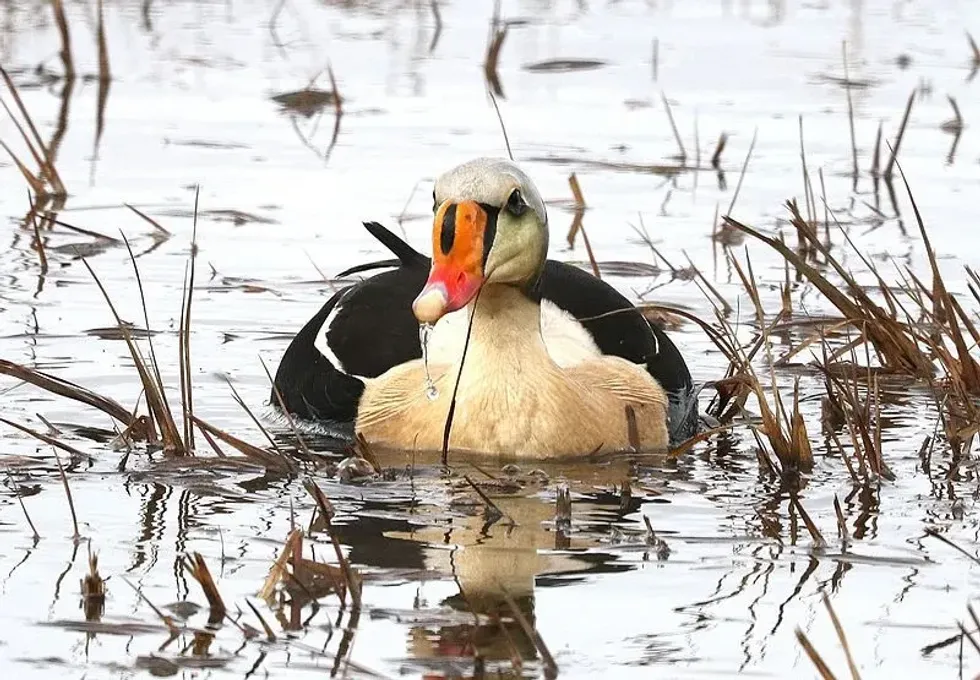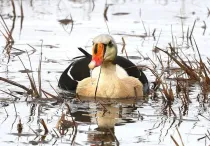The king eider is a sea duck. You can find it in regions of the Northern Hemisphere such as northern Alaska, Canada, Greenland, parts of northern Russia, and the Bering Sea.
While it primarily lives in high arctic regions among ice, in winter the king eider migrates south in large flocks to enjoy spring and summer temperatures. As a bird, the king eider's breeding method involves nesting and laying eggs which it incubates in nests made on the ground. Its main predators are gulls, ravens, arctic foxes, and humans.
These birds are most recognizable by the beautiful colors displayed by male birds, while young birds and females are mostly brown. King eiders are also very similar to common eiders, with whom they can breed.
Read on to find more king eider duck facts! If you enjoyed this article, why not read this article about the laughing gull or the grebe?
King Eider Interesting Facts
What type of animal is a king eider?
A king eider (Somateria spectabilis) is a sea duck.
What class of animal does a king eider belong to?
A king eider is a duck from the Aves class.
How many king eiders are there in the world?
The global population is estimated to be around 800,000-900,000 individuals. They are classified as a species of Least Concern, meaning their population is sufficiently large.
Where does a king eider live?
A king eider lives in polar habitats, including wetlands.
What is a king eider's habitat?
The king eider's habitat changes throughout the year as it migrates during the winter season, although it is always found in the northern hemisphere. During winter, it can be found in Arctic marine areas such as the coasts of Greenland, Canada, northern Norway or Alaska.
During its breeding season, the king eider can be found in tundras in Alaska, Canada, Greenland, and Russia.
Who do king eiders live with?
King eiders form large flocks when they gather during the winter in coastal areas. The largest flocks include more than 100,000 ducks. Female king eiders group together to raise their ducklings together. King eiders tend to live in groups but the male is not involved in the incubation period or raising the young.
How long does a king eider live?
The oldest recorded king eider was almost 19 years old! The lifespan of king eiders can vary considerably as they are a hunted species.
How do they reproduce?
As a species of duck, king eiders are oviparous, meaning they reproduce by mating and laying eggs. The female will have a litter size, or a clutch, of between four and seven eggs.
In order to protect her eggs, the female builds a nest on the ground made from her own feathers and scraps of vegetation. The incubation period lasts about 23 days, after which the ducklings are raised collectively by groups of female king eiders.
What is their conservation status?
The king eider is listed as a species of Least Concern due to its large population.
King Eider Fun Facts
What do king eiders look like?
As a species, the king eider is sexually dimorphic, meaning male and female members look very different. Male king eiders are slightly bigger than females and have a black body, white breast, and a multi-colored head.
Its head and neck are very pale blue or gray and its cheeks are pale green, while its beak (or bill) is red and white with a yellow tip.
Female king eiders are dark brown with black flecks (chevrons) all over their bodies. Their neck and head are slightly lighter than the rest of their bodies. Female king eiders have a light ring around their eyes and bill, while their bill is either black or gray.
Young king eiders are born with gray or brown feathers. They start transitioning to their adult plumage in their first year, but it takes up to three years for the young bird to reach full adult appearance.
How cute are they?
King eiders are cute and beautiful birds. Males especially, with their colorful heads are very elegant birds.
How do they communicate?
Male and female king eiders have slightly different techniques to communicate with their flocks. Males make cooing noises not unlike doves, while females cluck, grunt and growl.
How big is a king eider?
King eiders are a large species of ducks. On average an adult king eider is between 20-28 in (50-70 cm) long, two or three times the size of a hedgehog. They have a wingspan between 34-40 in (86-102 cm).
How fast can a king eiders fly?
King eiders can fly at speeds of 40 mph (68 kph), even faster with tailwinds. It has to be able to fly long distances in large flocks to its wintering habitat.
How much does a king eider weigh?
Male king eiders are slightly heavier than females. On average, a male king eider weighs 3.7 lb (1.7 kg) while a female weighs 3.5 lb (1.6 kg).
The weight of the king eider varies considerably depending on the time of the year. An individual king eider can go from weighing 2 lb (0.9 kg) to 4.9 lb (2.2 kg) in the space of a year, depending on the availability of food.
What are their male and female names of the species?
A female king eider is sometimes referred to as a queen eider. There is no other specific name to refer to the male king eider population.
What would you call a baby king eider?
As king eiders are sea ducks, a baby king eider duck is called a duckling.
What do they eat?
These sea ducks are carnivorous, but the king eider hunting pattern varies slightly depending on their location. When they are on breeding grounds in a tundra environment, they forage freshwater lakes and pluck their prey from the surface of the water.
The rest of the year, when they are at sea, they dive and fish for their prey. The king eider hunts mostly small invertebrates, mollusks, crustaceans, starfish, anemone, or sea urchins.
Are they dangerous?
No, king eiders are not dangerous to humans.
Would they make a good pet?
No, king eiders are wildlife birds who need a lot of space to fly and thrive in arctic environments such as tundras and arctic ocean coasts.
Did you know...
The king eider is very similar genetically to other members of the eider family such as common eiders. These two species are so closely related that king eiders and common eiders can breed between themselves and hybridize.
The scientific name of the king eider, Somateria spectabilis, comes from the Greek word 'soma' meaning 'body' and 'erion' meaning 'wool', in reference to its thick plumage. 'Spectabilis' comes from the Latin word for remarkable due to the impressive colors of the male king eider.
The common name of the king eider is a direct translation of the species' Icelandic name, in reference to the yellow tip above the male's bill which looks like a crown. The word 'eider' is derived from an Old Norse and Icelandic word for the species.
Do king eiders dive?
When they are at sea, in arctic ocean coastal areas, these birds dive to catch small invertebrates and sea creatures. Their specialty is that they can dive over 100 ft (30.5 m) to hunt their prey.
Where to hunt king eiders?
The king eider bird is a popular hunting target, especially in North America and in arctic regions. The sea bird is notably hunted in Alaska and the Bering Sea when they begin their migration in April and in northern Alaska and Canada in May, on their way to their breeding grounds.
Here at Kidadl, we have carefully created lots of interesting family-friendly animal facts for everyone to discover! Learn more about some other birds including the crested duck, or the swan.
You can even occupy yourself at home by drawing one on our duck coloring pages.










